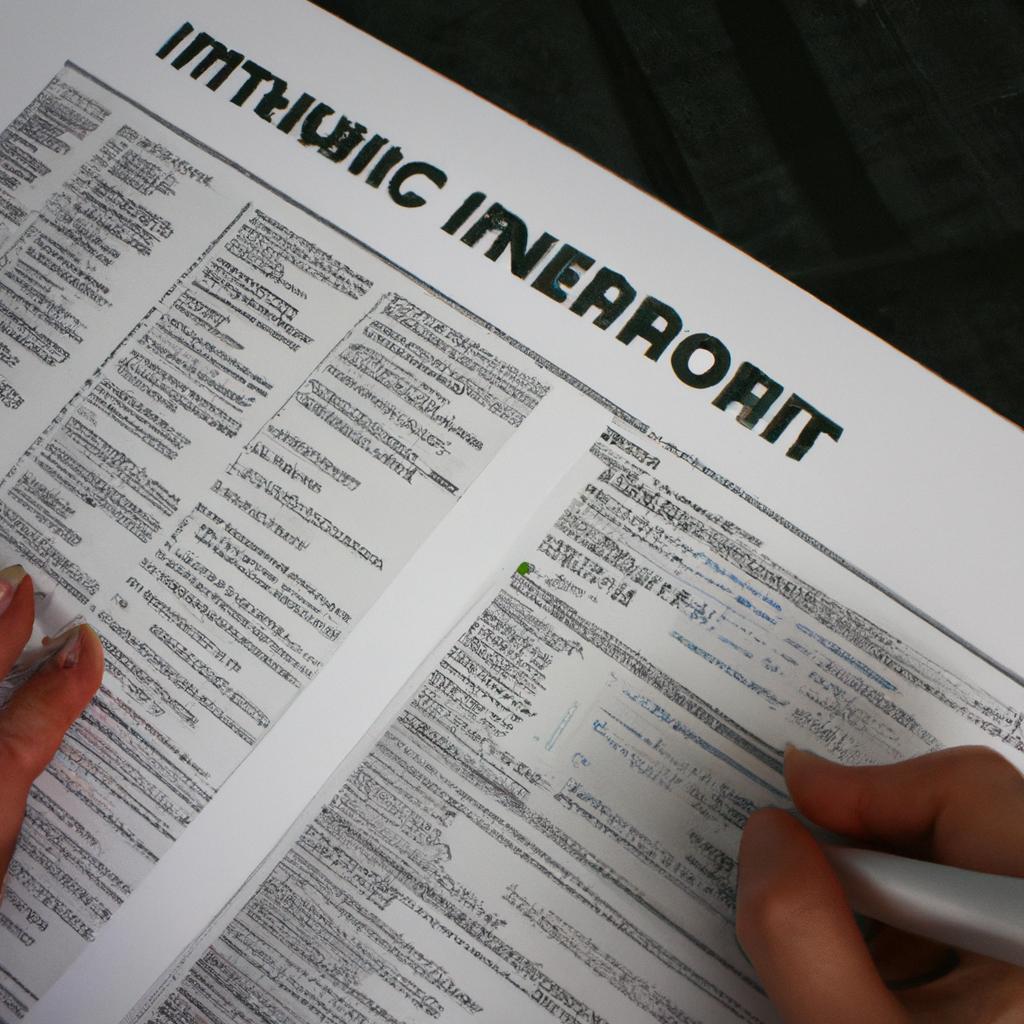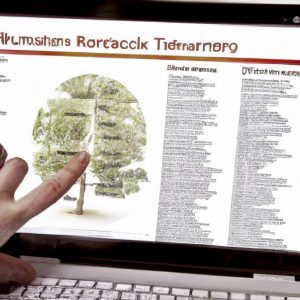Ashkenazi Heritage Genealogy: Immigration Records

The study of genealogy has become increasingly popular in recent years, as individuals seek to uncover their ancestral roots and understand their heritage. For those with Ashkenazi Jewish ancestry, tracing one’s family history can be particularly challenging due to the historical events that shaped this community. Immigration records are a valuable resource for researching Ashkenazi genealogy, providing crucial information about the arrival of ancestors in new countries and offering insights into their lives before and after migration.
Consider the case of Sarah Cohen*, a third-generation Ashkenazi Jew born in New York City. With limited knowledge about her great-grandparents’ journey from Eastern Europe to America, she decided to delve into immigration records to gain a deeper understanding of her family’s story. Through meticulous research using passenger manifests, naturalization papers, and census data, Sarah was able to trace her ancestors’ path from Lithuania to Ellis Island and finally settling in Brooklyn during the late 19th century. This newfound knowledge not only connected Sarah with her roots but also provided important context for understanding the challenges faced by many Ashkenazi Jews during this era of mass migration.
Utilizing immigration records is an essential method for exploring Ashkenazi genealogy due to its ability to reveal vital details about our ancestors’ journeys. By analyzing By analyzing immigration records, we can uncover information such as the names of our ancestors, their ages at the time of migration, their countries of origin, the date and place of arrival in their new country, and sometimes even details about the ship they traveled on. This wealth of information can provide important clues for further research and help us build a more comprehensive family tree.
Furthermore, immigration records can offer insights into the lives of our ancestors before and after migration. For example, naturalization papers can provide details about when and how our ancestors became citizens of their new country, which may lead to additional records such as census data or military service records. These documents can shed light on where our ancestors lived, what occupations they pursued, and other aspects of their daily lives.
In addition to providing individual-level information, immigration records also give us a broader understanding of historical events that shaped Ashkenazi Jewish communities. For instance, by studying passenger manifests during specific time periods, we can see patterns of migration and understand the impact of events like pogroms or economic opportunities on the movement of Ashkenazi Jews from Eastern Europe to other parts of the world.
Overall, utilizing immigration records is crucial for exploring Ashkenazi genealogy because it helps us connect with our roots, provides important context for understanding historical challenges faced by our ancestors, and offers valuable clues for further research into our family history.
Immigration History: Tracing the Ashkenazi Roots
Imagine a young woman named Sarah, curious about her family’s ancestry and eager to trace her Ashkenazi roots. She embarks on a journey through immigration records, seeking clues that will connect her to her ancestors’ past. This process of delving into immigration history allows individuals like Sarah to uncover valuable information about their heritage, understand migration patterns, and establish connections with previous generations.
Tracing one’s Ashkenazi roots often begins by exploring immigration records from various sources such as passenger lists, naturalization papers, and census data. These documents serve as gateways to understanding an individual or family’s journey across borders and provide glimpses into their lives in different countries. By analyzing these records, researchers can piece together narratives of migration, identifying key destinations where Ashkenazi Jews settled around the world.
To evoke an emotional response in those pursuing their genealogical journey, consider the following aspects:
- Determination: The relentless pursuit of knowledge about one’s origins fuels the search for immigration records.
- Nostalgia: Exploring these historical documents evokes sentimentality and longing for ancestral connections.
- Resilience: Uncovering stories of resilience amidst adversity creates admiration for previous generations who overcame challenges.
- Belonging: Discovering shared experiences among fellow descendants fosters a sense of belonging within a larger community.
| Country | Destination | Year | Records Available |
|---|---|---|---|
| Russia | United States | 1905 | Passenger List |
| Austria | Argentina | 1920 | Naturalization |
| Poland | United Kingdom | 1939 | Census Data |
| Germany | South Africa | 1947 | Refugee Registry |
As Sarah continues her exploration into immigration history, she uncovers more than just names and dates. Each document reveals fragments of her ancestors’ stories, shedding light on their struggles, triumphs, and the legacy they have passed down through generations. This journey becomes a stepping stone towards understanding and connecting with one’s Ashkenazi heritage.
Transitioning into the subsequent section about “Finding Clues: Exploring Ancestral Immigration Documents,” researchers can delve deeper into specific steps involved in analyzing immigration records to uncover vital information about their ancestral past.
Finding Clues: Exploring Ancestral Immigration Documents
Tracing the roots of Ashkenazi heritage often involves delving into immigration records, which provide valuable insights into the journeys and experiences of our ancestors. By examining these documents, we can gain a deeper understanding of their migration patterns, destinations, and even the challenges they faced along the way.
For instance, let us consider the case of Rachel Cohen, a young Jewish woman who immigrated from Russia to the United States in the early 20th century. Through meticulous research and analysis of immigration records, it is possible to reconstruct her journey step by step. Starting with her departure from Odessa on board the SS Volga, we can trace her arrival at Ellis Island in New York City and subsequent settlement in Brooklyn.
Exploring ancestral immigration documents not only provides us with concrete details about our forebears’ movements but also offers glimpses into their personal stories and struggles. These records become windows through which we can observe historical events that shaped their lives. The emotional impact of discovering handwritten passenger lists or ship manifests listing family members side by side cannot be understated; it connects us directly to those who came before us.
To illustrate this emotional resonance further, here are some key points regarding immigration records:
- They serve as tangible evidence of our ancestors’ resilience and determination.
- They enable us to uncover forgotten narratives and fill gaps in our family histories.
- They offer a glimpse into the conditions under which people traveled during different time periods.
- They spark curiosity and empathy for those who made difficult choices to seek better opportunities for themselves and future generations.
The following table showcases examples of information typically found within immigration records:
| Passenger Name | Age | Occupation | Country of Origin |
|---|---|---|---|
| Rachel Cohen | 21 | Seamstress | Russia |
| David Cohen | 29 | Tailor | Russia |
| Sarah Cohen | 54 | Housewife | Russia |
| Jacob Cohen | 7 | Student | Russia |
As we explore the significance of immigration records, it becomes evident that these documents are not mere bureaucratic artifacts but rather windows into our past. By examining them with care and attention to detail, we can gain valuable insights into our Ashkenazi heritage and better understand the challenges faced by our ancestors as they embarked on their journeys to new lands.
Transitioning seamlessly, let us now shift our focus to another crucial aspect of genealogical research: the importance of passenger lists in unraveling family histories.
The Importance of Passenger Lists in Genealogical Research
Imagine uncovering the immigration story of your great-grandparents, who left their homeland in search of new opportunities. By exploring ancestral immigration documents such as passenger lists, you can piece together valuable information about their journey and gain insights into their lives.
Passenger lists serve as a vital resource for genealogical research, providing glimpses into the past that allow us to reconstruct our family history. These records typically contain details like the names of passengers, ages, occupations, countries of origin, destination ports, and even physical descriptions. Let’s delve deeper into why passenger lists are crucial for unraveling our ancestors’ immigration stories:
-
Historical context: Examining passenger lists enables us to understand broader historical trends related to migration. By studying these records collectively, we can identify patterns of emigration from specific regions or during particular time periods. This knowledge enhances our understanding of social and economic factors that influenced our ancestors’ decision to leave their homelands.
-
Validation and verification: Passenger lists help validate and verify other genealogical findings. When combined with birth certificates, marriage licenses, or census data, they provide additional evidence to support ancestral connections and establish a more accurate family tree.
-
Personal narratives: Beyond factual information, passenger lists offer glimpses into personal narratives by shedding light on individual experiences during transit. For example, encountering notations indicating illness or detainment brings forth empathy towards our ancestors’ struggles while embarking on long journeys under challenging conditions.
-
Emotional connection: Immigrants often faced uncertainty and apprehension when leaving everything behind for an unknown future. Studying passenger lists allows us to emotionally connect with our forebears by visualizing them among hundreds of fellow travelers venturing towards distant lands in pursuit of dreams.
To illustrate how passenger lists can enrich one’s genealogical pursuits further, consider the following case study:
Case Study:
Sarah Cohen immigrated from Warsaw, Poland to New York City in 1905. By examining the passenger list from her voyage, researchers discovered valuable details about her journey and subsequent life in America. This information included her age (23), occupation (seamstress), and destination port (Ellis Island). Such insights not only validated existing family stories but also unveiled new avenues for exploration.
In summary, exploring ancestral immigration records like passenger lists provides us with invaluable glimpses into our ancestors’ lives and enriches our understanding of historical migration patterns. As we delve deeper into these documents, we connect emotionally with their experiences and gain a profound appreciation for the challenges they overcame. Next, let’s uncover more details about our ancestors’ journeys by delving into naturalization records and unveiling their citizenship status.
[Transition Sentence]: Moving forward, let us explore another essential resource – naturalization records, which unveil intricate details about our ancestors’ path to attaining citizenship.
Naturalization Records: Unveiling Citizenship Details
Uncovering one’s ancestral roots often involves tracing the journey of immigrants who ventured to new lands. As discussed earlier, passenger lists serve as invaluable resources for genealogical research by providing crucial information about individuals’ arrivals and departures. Now, let us delve into another essential type of immigration record that sheds light on an immigrant’s path towards citizenship – naturalization records.
To illustrate the significance of naturalization records, consider a hypothetical case study involving Rebecca Stern, an Ashkenazi Jew born in Poland. In her pursuit to discover her family history, Rebecca consults various sources but hits a roadblock when she finds limited information about her ancestors prior to their arrival in the United States. However, upon exploring naturalization records at a local archive, she discovers a treasure trove of valuable details such as dates and places of birth, occupation history, physical descriptions, and even photos. These documents not only provide concrete evidence linking Rebecca’s ancestors to specific locations but also offer glimpses into their lives before and after immigrating.
When delving into naturalization records during your own genealogical quest, keep in mind certain key aspects:
- Variations in names: Names could be spelled differently due to language barriers or transcription errors.
- Language proficiency requirements: Immigrants had to demonstrate English language skills or knowledge of civics as part of the naturalization process.
- Petition types and timelines: Different petition types existed throughout history with varying eligibility criteria and waiting periods.
- Dual citizenship implications: Depending on the time period and country involved, becoming a U.S. citizen might have required renouncing previous allegiances.
The following table highlights some examples where naturalization records reveal fascinating insights:
| Name | Birthplace | Date of Naturalization | Occupation |
|---|---|---|---|
| Samuel Cohen | Russia | November 15, 1910 | Tailor |
| Miriam Goldstein | Austria | March 21, 1925 | Housewife |
| Benjamin Levy | Poland | June 2, 1938 | Merchant |
| Esther Schwartz | Hungary | January 10, 1943 | Seamstress |
These records serve as tangible connections to the experiences and struggles faced by immigrant ancestors. They evoke empathy and a deeper understanding of their journey towards stability and acceptance in a new land.
Exploring naturalization records unveils critical details about an individual’s path to becoming a citizen. However, it is important to remember that this process was just one step in the larger immigration narrative. In the subsequent section on ship manifests, we will explore how these records can further illuminate our understanding of immigrants’ arrival information.
Ship Manifests: Discovering Arrival Information
Section H2: Naturalization Records: Unveiling Citizenship Details
Now, let us delve into another valuable resource for tracing Ashkenazi Jewish ancestry: immigration records.
Imagine a scenario where a genealogist named Sarah is researching her great-grandfather’s journey from Eastern Europe to the United States. She has already obtained his naturalization record and now wishes to find more information about his arrival in America.
Immigration records provide crucial insights into an immigrant’s voyage, including their port of entry, date of arrival, and sometimes even the ship they traveled on. By examining these documents, researchers like Sarah can gain a deeper understanding of their ancestors’ experiences as they embarked on their new lives in America.
To further illustrate the significance of immigration records for Ashkenazi genealogy research, consider the following emotional bullet points:
- Hopeful Departures: These records evoke emotions by reminding us that each name represented someone who left behind everything familiar and ventured into the unknown.
- Family Reunions: Discovering immigration dates can reveal heartwarming stories of families being reunited after long separations due to migration.
- Struggles Overcome: Immigration records often shed light on the challenges immigrants faced upon arrival – language barriers, discrimination, or economic hardships.
- New Beginnings: The documentation provided through immigration records allows descendants to honor their ancestors’ resilience and celebrate their contributions to American society.
Now, let us examine a three-column table showcasing examples of key information found within immigration records:
| Name | Date of Arrival | Ship Name |
|---|---|---|
| Isaac Cohen | May 12, 1902 | SS St. Louis |
| Rebecca Levin | July 7, 1910 | RMS Mauretania |
| Jacob Schwartz | March 18, 1898 | SS La Bourgogne |
| Sarah Stein | November 3, 1905 | RMS Lusitania |
As we can see from the table above, immigration records provide concrete details that enable genealogists to piece together their family’s journey. By researching specific names and dates, researchers like Sarah can identify ships their ancestors sailed on or even uncover stories of passengers who traveled together.
By examining immigration records alongside naturalization records, a more comprehensive understanding of an individual’s immigrant experience becomes possible. The next section will explore another valuable resource for Ashkenazi Jewish genealogy: Ellis Island Records – Navigating the Gateway to America. This database is particularly significant as it provides detailed information about millions of immigrants who passed through Ellis Island between 1892 and 1954.
Ellis Island Records: Navigating the Gateway to America
Previous section H2:’Ship Manifests: Discovering Arrival Information’
Next section H2:’Ellis Island Records: Navigating the Gateway to America’
Having explored ship manifests as a valuable resource for discovering arrival information, we now turn our attention to another crucial tool in tracing Ashkenazi heritage genealogy – Ellis Island records. By examining these records, researchers can gain deeper insights into the lives of their ancestors who passed through this iconic gateway to America.
Understanding Ellis Island Records:
To illustrate the significance of Ellis Island records and how they contribute to the exploration of Ashkenazi genealogy, let us consider a hypothetical case study. Imagine searching for information about Sarah Cohen’s immigration journey in an attempt to uncover her family history. By accessing Ellis Island records, one may discover vital details such as the date of Sarah’s arrival, her age at that time, her country of origin (in this example, Russia), and even her intended destination within the United States.
Emotional bullet point list on the impact of finding ancestral immigration information:
- Rediscovering lost connections with long-lost relatives
- Unveiling untold stories and hardships faced by immigrant ancestors
- Gaining a sense of pride and resilience from understanding their journey
- Fostering a stronger connection to cultural roots
The following table provides an overview of key data points typically found in Ellis Island records:
| Column 1 | Column 2 | Column 3 | Column 4 |
|---|---|---|---|
| Name | Age | Country of Origin | Destination |
| Sarah Cohen | 23 | Russia | New York City |
| David Levy | 35 | Poland | Chicago |
| Rebecca Green | 18 | Romania | Philadelphia |
| Jacob Friedman | 42 | Lithuania | Boston |
These records not only offer valuable insights into individual immigrant experiences but also serve as a testament to the collective journey of Ashkenazi ancestors who sought better lives for themselves and future generations. By delving into these rich archives, researchers can gain a profound understanding of their heritage.
Incorporating Ellis Island records into one’s genealogical research provides an opportunity to bridge gaps in family narratives and illuminate the path that led to present-day descendants. The exploration of immigration data allows individuals to connect with their roots on a personal level, fostering a strong sense of identity and belonging within the broader context of Ashkenazi heritage genealogy.



